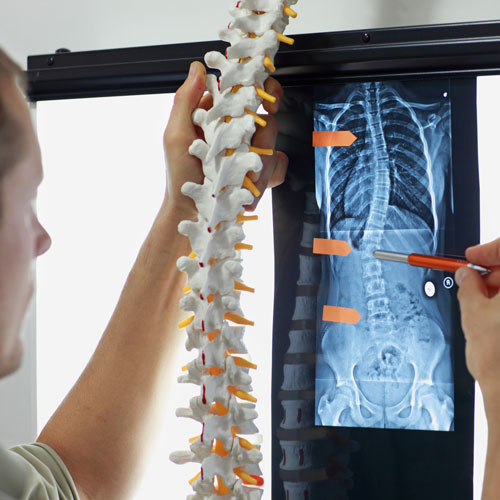Blogs
The Effects of Spinal Misalignment on the Body
 Spinal misalignment is extremely common among both adults and children – but most people don’t know that they’re experiencing it! Because of this, many individuals assume that their current baseline of health can’t improve much.
Spinal misalignment is extremely common among both adults and children – but most people don’t know that they’re experiencing it! Because of this, many individuals assume that their current baseline of health can’t improve much.
Countless numbers of adults believe that the pain, stiffness, inflexibility, or numbness that they feel in their bodies is simply a natural byproduct of their body’s structure and something that they will have to live with for the rest of their lives. Fortunately, at Back in Motion P.S. Chiropractic of Spokane, Washington, we know that this is not the case.
Chiropractic care is the leading treatment in correcting spinal misalignment in the body without surgical intervention. Individuals who a) didn’t know they had misalignment which was contributing to their discomfort, or b) knew that they had misalignment but didn’t realize that it could be addressed, find relief with expert chiropractic care every day.
In both instances, people are often shocked to discover that not only is their spinal misalignment highly treatable, but it is often creating other health problems that have been misattributed to other causes.
What is spinal misalignment?
Spinal misalignment is a relatively vague term with a very specific meaning: it is the occurrence of a spinal curvature that does not match the optimal and natural curvature of the spine. Every human spine has a distinct curvature that allows the body to function optimally.
When the spinal curvature is normal, the body’s structure is balanced and proportionate, the body’s organs are protected and allowed to function efficiently, and the body is flexible and mobile enough to carry out everyday tasks and activities with ease. When the spinal curvature is normal, there is no inexplicable pain in the body.
Muscles, tendons, and ligaments are not strained or compressed in an attempt to compensate for irregular posture. Body tissue and nerve bundles are not constricted and nerve flow is uninhibited and regular. When spinal curvature is normal and optimal, posture is excellent.
The head is positioned squarely above the shoulders, there is no additional pressure being placed on the neck, the shoulders are pulled back and sitting in the middle of their sockets. When spinal curvature is normal, it does not require great effort to support the body or sustain proper posture.
The muscles of the back are flexible and loose, and the body exhibits health mobility. In short, ideal spinal curvature allows the body to move easily and feel comfortable.
When the spinal curvature is abnormal and shifted, a multitude of imbalances can occur as a result. Spinal curvature can be shifted only minimally, meaning that the spine and joints are just a few degrees away from their ideal curve.
In other cases, like scoliosis, the spinal curvature is significantly shifted away from its ideal, natural curvature. Both instances can be aided with the help of chiropractic care, and both instances create imbalances in the body—the severity of which often correlates with the number of degrees of distance from ideal alignment.
Symptoms of Spinal Misalignment
Aside from a diagnostic assessment in which x-rays and digital imaging is used to determine the spine’s alignment, there are other ways to tell if your spinal curvature has strayed from the optimal curve.
Please note that this is not a complete list and that the symptoms of spinal alignment can be different for every individual. That being said, there are commonalities between the ways that most individuals experience the consequences of spinal misalignment.
Digestive System
One of the most surprising and common ways that spinal misalignment can affect the body is in digestion. The digestive system has its own nervous system called the enteric nervous system.
When the spine is misaligned, this nervous system can experience inhibited communication and circulation from the central nervous system, which comprises the spine and the brain. The enteric nervous system is responsible for regulating digestive function, energy distribution, and healing outcomes in the body.
When the spine is misaligned, nerve bundles in the local area often become bruised and compressed, damaging their ability to function efficiently. This communication error can cause the energy transmitted from the central nervous system to the enteric nervous system to be reduced.
In severe cases of spinal misalignment, for example, scoliosis, the spine can actually begin to place pressure on the digestive organs, creating discomfort and reducing optimal function.
Nervous System
Because the central nervous system comprises the brain and spinal cord, the nervous system is one of the largest and most important systems that is affected by spinal misalignment. The central nervous system and peripheral nervous system work together to regulate sensation perception, motor control, hormone production and release, and cognition.
Any and all of these functions can be compromised when the joints of the spinal cord are experiencing subluxation, or when the bones have become misaligned.
Pain
Spinal misalignment forces the muscles, ligaments, tendons, and tissues of the body to work against their natural function by trying to support the body’s structure. Because the body is always striving to return to homeostasis, the body will attempt to compensate for poor misalignment in other ways.
This, in combination with pinched nerves, can create pain all over the body. Pain commonly felt from spinal misalignment is dull, aching pain in the middle and low back and neck, as well as shooting, sharp pain across the neck, posterior, and back.
Sleep
Mattress companies would have you believe that it’s your mattress that is causing your back pain – but that’s not always the case. In fact, many people have to work to seek out a mattress that will provide them with comfort.
This is not because most mattresses are inferior – it’s because most spines are misaligned! Individuals with optimal spinal curvature can find comfort on most surfaces. When the spine is misaligned, the sleeping position becomes an extremely meticulous process of finding the right pillow(s) and the right mattress, as well as the right sleeping position, all of which are required to gain comfort and achieve rest.
Cognition
Cognition is largely connected to both the nervous system and the spine. When the spine is misaligned, stagnation can occur in the circulation of cerebrospinal fluid, which plays a role in delivering nutrients to the brain as well as detoxification of the brain.
If the connection between the lower spine and brain is misaligned, this can compromise the effect of cerebrospinal fluid circulation, as well as decrease the energy being transmitted through nerve connections to and from the brain.
Stiffness & Inflexibility
If you find that your back, neck, and shoulders are stiff and inflexible, and you are not in advanced age, this may be due to spinal misalignment. The spine begins to lose flexibility as it becomes detoured further and further from optimal alignment.
As we know, the effect of misalignment on the muscles, tissues, and ligaments can also create stiffness, as these parts of the body struggle to support the body’s structure in the absence of ideal alignment.
Posture
Forward head posture, rounded or uneven shoulders, uneven hips, or legs of a different length are typically indicative of spinal misalignment. This is a chicken and egg situation because posture and alignment affect one another bidirectionally.
This means that as one changes, the other changes in equal proportion. Put simply, poor postural habits can lead to misalignment, and misalignment can lead to poor postural habits. Regardless of the origin of the postural concerns or the misalignment, chiropractic care can help.
Respiration & Circulation
When the spine drifts away from its ideal curvature, breathing and heart rate can be affected. When the spinal curve is severe (i.e., in the case of scoliosis), the physical organs of the head and lungs can become compressed, leading to direct inhibition of their function.
When the spinal curvature is less severe, it will still affect the nervous system, which is responsible for regulating the function of respiration and circulation. If you experience shallow breathing, rapid or irregular heart rate, or light-headedness and numbness in your extremities without any other identifiable cause, it’s likely that you’re also experiencing spinal misalignment.
Chiropractic Care Can Help
For each of these effects of spinal misalignment, chiropractic care can help. In particular, expert chiropractor Dr. Cameron Weishaar of Back in Motion P.S. Chiropractic specializes in correcting spinal misalignment through Chiropractic BioPhysics®, a form of chiropractic care designed to produce long-term alignment correction.
If you live in the Spokane, Washington area and are ready to resolve the chronic and insidious side effects of spinal misalignment, then book your appointment today.

